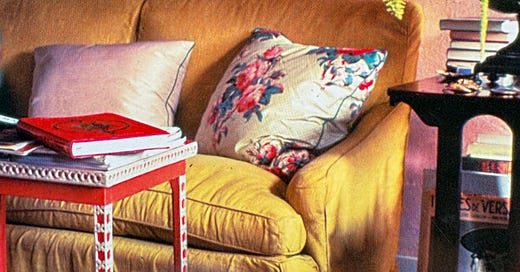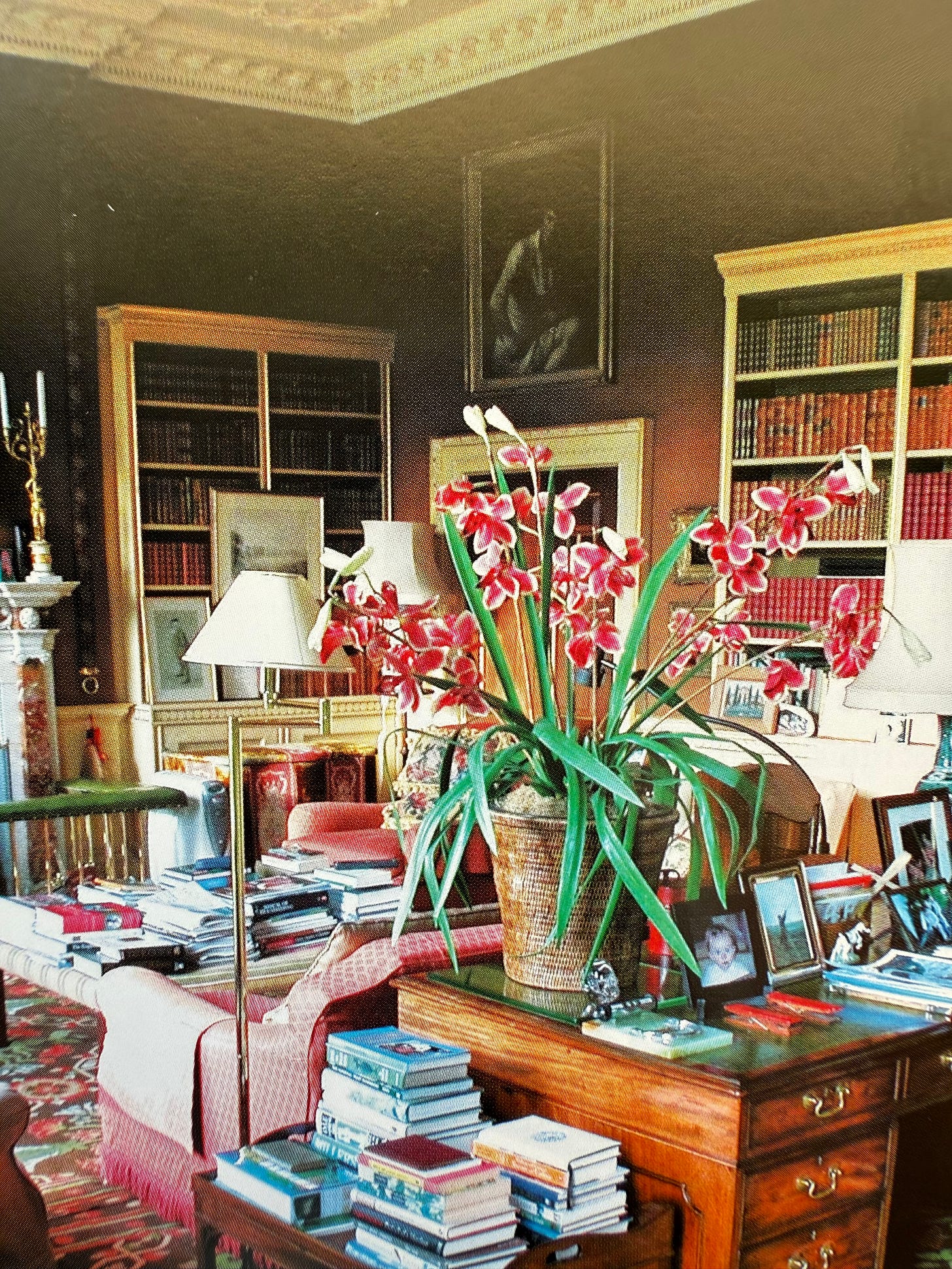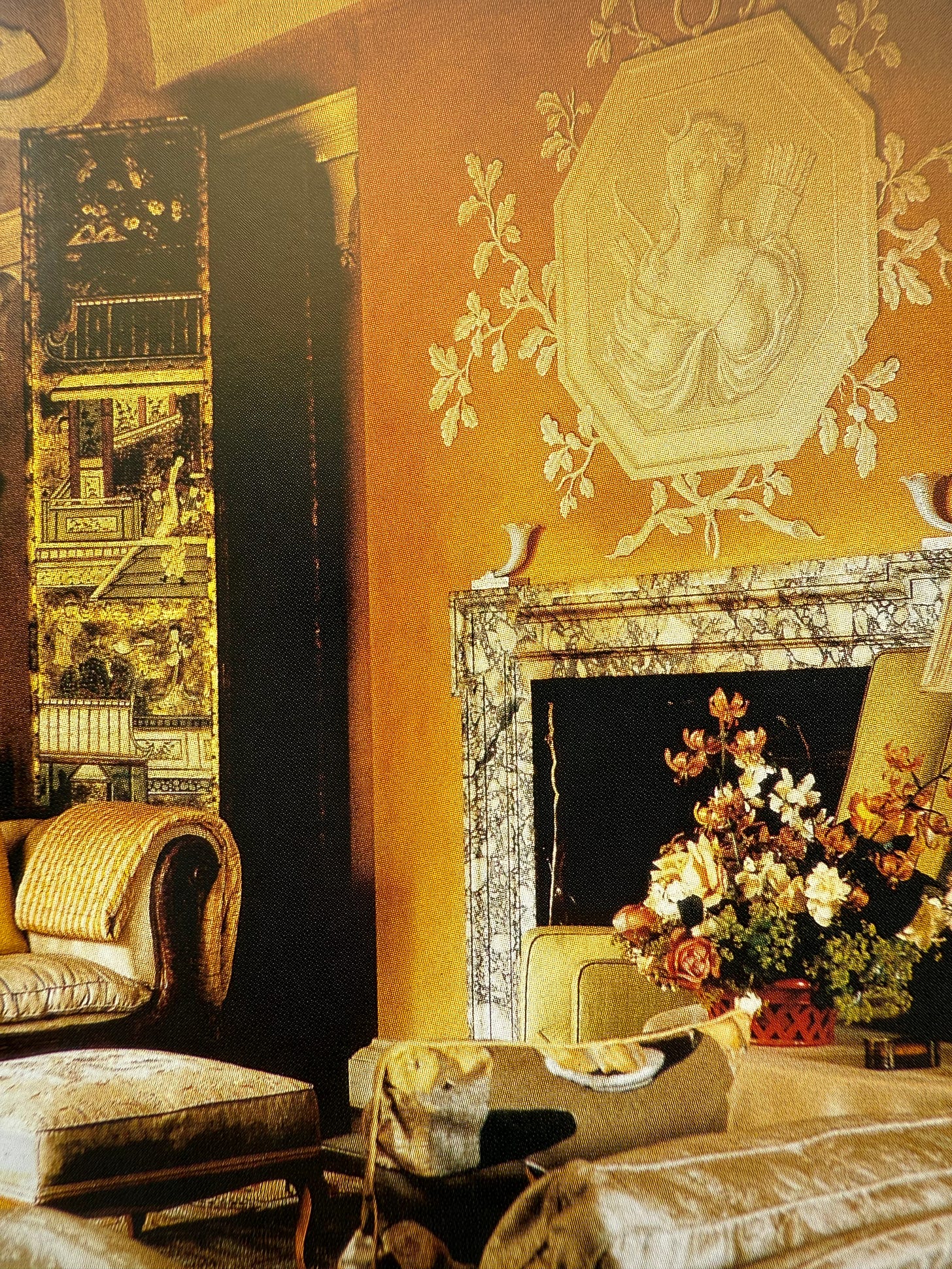On the Shelf: Snippets, Spaces & Slower Ways of Seeing
Notes from the library: what old books and beautiful rooms keep teaching me. Rediscovering interiors through the philosophy of Ilse Crawford and John Fowler.
Lately, I’ve found myself retreating into my library more often than usual—pulled toward the quiet weight of pages and the pleasure of sifting through old favorites and forgotten treasures. There’s something deeply grounding about tangible books, especially in a world that so often spins on scroll-speed.
My shelves are a mix of the familiar and the surprising: beloved tomes by favorite designers and thinkers, yes—but also the odd vintage gems I’ve stumbled upon at estate sales, flea markets, and dusty secondhand shops. The kind of books that smell like age and wisdom. The kind that beg to be rediscovered with a cup of tea in hand.
I love the work it takes to sift through them. It’s not passive, like flipping through Pinterest or getting swept up in Instagram’s current of trends. It’s more deliberate. A different kind of seeing. I find that this process—page by page—shapes my eye in ways that feel entirely my own. The philosophies of design are best devoured slowly, in full sentences. They stick more that way.
When I read, I feel like I’m eavesdropping on the past. I mark passages, dog-ear pages, scribble notes in the margins. Some lines stop me mid-read. Others haunt me for days. These snippets—some odd, some beautiful, some quietly profound—have been feeding me lately, and I thought I’d share a few...
Ilse Crawford is more than a designer—she’s a philosopher of space, a quiet prophet of how our environments shape our well-being. Her work doesn’t just look good; it feels good.
With a background in journalism and an eye for the emotional life of interiors, she designs with the human experience at the center—warmth, light, comfort, and ritual. Her spaces aren’t about perfection or prestige; they’re about presence. In many ways, she’s been whispering truths about holistic, sensory design long before the industry caught on.
She's undoubtedly one of my favorite thinkers when it comes to design, and I find myself returning to her ideas over and over again—especially in seasons when I need to be reminded of the deeper meaning and importance that interiors have on our lives.
Home Is Where the Heart Is by Ilse Crawford
Home Is Where the Heart Is is a thoughtful meditation on the emotional role of interiors. Part design book, part philosophical guide, it explores how our homes can—and should—support the rituals, relationships, and small pleasures of everyday life.
Rather than focusing on style trends, Crawford urges us to design from the inside out, guided by how a space makes us feel.
“Real comfort is not about luxury. It is about a room that works easily, that feels like part of your life.”
With chapters on light, tactility, color, and the poetry of domesticity, Crawford makes the case for a slower, more human-centered approach to design. The book is both visually rich and deeply grounding—a gentle reminder that home isn’t a showroom, but a living, breathing place to belong.
“Over the last decade, through my work and my teaching, I have developed an agenda of working to create design that is a frame for life; a design that starts with human experiences, that prioritizes our wellbeing and enhances our humanity.... I am fascinated by what drives us, brings us together and ultimately makes us feel alive.”
“Home is so much more than bricks and mortar. It is such an interesting construct. On the one hand, it is a receptacle to house objects and people. And on the other, it is a living thing; constantly in flux, as changeable as the people that live in it and a vessel for so many different activities. Home is a practical way to weave our many emotional needs into daily life. As John Berger said, ‘without a home, everything was fragmentation.’
Home is a place to do the ordinary things. It is a place to be ourselves and to channel our better selves—to create well-being, connection, warmth, and to draw attention to the small rituals and gestures that give life meaning and value. Home is also a kind of melting pot. It's a place where the things that matter can come together. A safe house where the occupants’ characters converge. And where all the diverse parts of an individual converge. Whether it's a rather iffy taste in music or a compulsion to pick just the right shade of grey. There is no place to hide. And that is precisely what is so good about it.
You grow up and grow old there. You grow together. For most, just the sounds of home make everything feel in its right place. Nostalgia in its original meaning was defined as a deep-seated yearning for home.”
A Frame for Life — Studioilse
A Frame for Life offers a deeper look into the work and ethos of Studioilse, Ilse Crawford’s design studio known for creating environments that prioritize the human experience. Through case studies of homes, hotels, shops, and public spaces, Crawford illustrates her belief that good design starts with empathy and ends with spaces that support life in all its complexity.
“Design is a tool to enhance our humanity. It can make life better.”
The book is equal parts manifesto and monograph, revealing Crawford’s signature blend of sensual materials, honest craftsmanship, and thoughtful restraint. Each project reflects her ongoing question: How does this space make people feel?
A Frame for Life is a compelling invitation to think differently about the environments we create—and a powerful reminder that beauty is only meaningful when it’s in service of well-being.
“A wholehearted home frames the complex patterns of living, while leaving room for the individual experience. It underpins the needs of the people who live there, while giving freedom for expression.... Our homes should grow with us. Life isn't fixed, so spaces can't be either.”
Defining the Frame
Priorities
Where do you spend most of your time?
Which spaces do you use the least?
What is your most important ritual?
How much privacy do you need?
If you live with others, do you share the same activities?
Do you each need your own surfaces, so your papers don't get mixed up?
Does one of you get up much earlier than the other?
Do you entertain?
Do you have people stay over?
Do you work from home?
Are you someone who likes to be warm? Or cool?
Where do you relax?
How often do you use your sitting area?
Do you need space for exercise?
Are you messy or neat?
Are you ecologically conscious with your purchases?
John Fowler: Prince of Decorators by Martin Wood
Martin Wood’s John Fowler: Prince of Decorators is a richly detailed portrait of one of Britain’s most influential interior designers, chronicling his life, his work, and his enduring legacy in the world of English decoration.
Known for his role in co-founding the iconic firm Colefax & Fowler, Fowler helped define what we now recognize as the quintessential English country house style—unpretentious, romantic, deeply layered, and always personal.
The book dives into Fowler’s genius for mixing faded grandeur with quiet comfort, his obsession with patina and proportion, and his intuitive sense for creating rooms that felt timeless yet lived-in. He treated color like a whisper and upholstery like sculpture. His philosophy was less about trend and more about tradition—
“Not slavishly copying the past, but using it as a springboard for something fresh.”
“Taste is a sharpened eye for the beautiful, the interesting, and the unusual—coupled with the talent to apply all of these to one’s life.” —John Fowler
Wood traces Fowler’s humble beginnings, his early fascination with theatrical design, and his eventual rise to decorating royalty, with clients including the British aristocracy and even the Royal Family. But beyond the grand names and historic houses, it’s Fowler’s devotion to atmosphere that remains most inspiring.
“I like the lived-in look, where dogs and children are as much a part of the room as the furniture.”
With anecdotes, letters, photographs, and rare insights, John Fowler: Prince of Decorators is both a biography and a masterclass. It’s a must-read for anyone drawn to the layered, imperfect charm of English interiors—and to the idea that good design, above all, should be deeply felt.
Thanks for spending a few quiet moments here with me—tucked between pages, dust jackets, and the soft hum of well-loved spaces. I’ll be sharing more from the shelf soon—books that linger, lines that shift the way I see and the ideas that help shape the homes we make, both inside and out.
Until then, here’s to slower ways of seeing.
Sara Kate
















